#Paddington hotels London
Explore tagged Tumblr posts
Text
Hilton London Kensington Holland Park Avenue
Hilton London Kensington Holland Park Avenue The Hilton London Kensington is a well-known hotel located on Holland Park Avenue in the Kensington district of London. The hotel is close to popular areas like Notting Hill, Kensington High Street, and the Westfield London shopping center. It’s a good option for both business and leisure travelers, offering modern amenities like a fitness center,…

View On WordPress
#hilton brands#hilton holland park#hilton honours#hilton hotel kensington#hilton hotel london#hilton hotels#hilton inn#hilton kensington#hilton london#hilton london england#hilton london kensington#hilton london kensington hotel#hilton london olympia#hilton london olympia hotel#hilton london paddington#hilton london uk#hilton olympia#hilton paddington#hilton park lane#hilton reservations#hilton shepherds bush#hotels in london#hotels in south kensington london#hotels london#hotels london uk#kensington court hotel#kensington hotel#kensington hotel london#london hilton hotel#south kensington hotels
0 notes
Text
London Tourism: Winston Churchill Edition

History has a big role to play in London tourism, with Winston Churchill one of the most iconic and well known names from 20th century politics. In his role as Prime Minister, Winston Churchill had a major impact on the way that Britain was run during WW2 with his time as a wartime leader and figure in Britain making his presence across London something that is still recognised today.
For those visiting London to get a flavour of the city’s history, here are some of the places to add to your list which are directly linked with Churchill – the first of which is located a stone’s throw from The Queens Park hotel.
National Portrait Gallery
Home to portraits and paintings of some of Britain’s most distinguished names, leaders, and celebrities, it follows that there are a number of paintings and statues which depict Winston Churchill to be found throughout the gallery. From those which he posed for, to those done from memory or from existing portraits, the culmination of artwork showcasing Churchill throughout his life and career make this a great attraction in which to immerse yourself in the history of the former Prime Minister.
Churchill War Rooms
Located on the very site of the war rooms in Westminster used during WW2, not only have these war rooms inspired movies and television programs but they are also an iconic stopping point for history lovers – surrounded by convenient double room hotels for London tourists.
The war rooms remain as they were during the war, presenting a network of underground spaces which include the map room and the various rooms where Churchill and his team directed the war effort.
Another part of the Churchill war rooms experience includes the Churchill museum, which allows visitors to see love letters between Winston and his wife, artifacts, cigars and the possessions which epitomise the life of the leader in one place.
Westminster Abbey
A well known London landmark located within close proximity to the top hotels near Paddington London and other central spots, Westminster Abbey not only hosted a number of ceremonies and events which Winston Churchill himself attended, but is also where a green marble commemorative stone is laid in his memory. The stone, laid and unveiled by Queen Elizabeth II in 1965, commemorates both the life of Churchill and the war effort in which he played a significant role.
House of Commons statue
The House of Commons is one of the most famous places where you will find a status dedicated to Winston Churchill, with visitors staying in one of the nearby twin room London hotels able to see both the Churchill arch and the bronze figure statue where it stands by the Commons entrance arch.
So much of Winston Churchill’s time in Parliament was spent in the House of Commons, with Westminster Hall beyond the arch also playing host to a memorial plaque in the spot where Churchill’s coffin lay upon his death.
Beyond these most obvious stopping points on a historical tour of London through the eyes of Churchill, visitors can explore many other sites and landmarks that played a part in his leadership. Let us know where your tour takes you!
#twin room London hotels#hotels near Paddington London#double room hotels for London#The Queens Park
0 notes
Text
A Family Trip to Liverpool | Bruce Wayne/Batman x OC!Magician with BatFam
Synopsis: Bruce and Vivian takes the Batfamily on a vacation to Liverpool but not everyone is enthusiastic about it. A fluff family piece.

"When we said we wanted to go on a vacation, this isn't what we mean by it," Tim pointed to the view of the busy London road and heavy rain that welcomed them at the airport.
"We already went to sunny beaches last year," Vivian told him. "And I find it offensive that you don't like it here."
"No offense, Ma, it's just... if we wanted rain, we would have stayed in Gotham," said Jason as he placed one of their bags in the car that came to pick them up.
Dick went to Tim and Jason and swatted them behind their heads. "Be sensitive. "
Turning to Vivian, they saw how she kept up the look of not being bothered by their comments by fastening Valerie in her car seat. She didn't want to show them that their comments bothered her but it did. Vivian has been planning on taking them to Liverpool for a while now, they were supposed to go a couple of months back but it kept getting canceled because of missions and work.
The trip was mostly for Valerie, so their sister could see her cousins, her aunt and uncle, and her grandfather. Other than that, it was so Valerie can also see where her mother grew up.
Finished with putting their bags away, Bruce closed the trunk of the hotel van that came and told them to get in with a disappointed tone in his voice. He wasn't the only one giving them the look, there was Damian and Alfred too.
The hotel they booked was a little closer to Vivian's childhood home, making it easy for them to visit Adam. Bruce booked a penthouse that can give them the space and the rooms that can accommodate their big family.
"Mom, look!" Valerie ran to her bed in the room she and Cassandra shared. She climbed the tall bed, refusing help from anyone, and showed the Paddington Bear.
Vivian and Bruce joined their daughter on her bed and read the card that came with it.
"Did you tell Oli where we staying?" Vivian asked Bruce.
"I did. Looks like he wanted to surprise Val. Both him and Olivia," he took the mini boxing gloves from the bedside and showed it to Vivian. "From Olivia."
"I see the gym is doing well now" She showed Valerie the gloves. "Punch your brothers' ball with this."
Valerie giggled.
"When we get to Grandda's tell Uncle Oliver and Aunt Liv thank you, okay?"
"I will!" Valerie said then she went to join Cassandra who called for her to show the view of their window. "Mommy, Da, look! I can see the river from here!"
"We'll head there with Grandda and we're going to ride the ferry," Vivian told her daughter.
Happy with the plan, Valerie raised a thumbs up at her mother then pointed to Cassandra the next thing she saw.
After telling Cassandra that they were going to fix their things in their room, the couple left and closed the door of the master bedroom before any of the boys can approach her.
Vivian laid on the bed. "Nothing beats a good hotel bed."
Bruce joined her. "Reminds me of the time you slept away the first day of our honeymoon."
"It was a really good bed."
"Really? Not the fact I tired you out the night before?" He took her hand and caressed the wedding ring and the engagement ring she wore.
"It was mostly the bed."
"Maybe I need to fix that--are you seriously falling asleep now?"
Vivian fought to keep her eyes open, "It was a thirteen-hour flight. Its a wonder how Val is up and active now."
"Get some rest, I'll fix our things."
"Don't bother," she waved her hand and their luggage started opening and their clothes were hanged in the closet. "Stay here with me."
Bruce adjusted himself so Vivian can lay in his arms but, to his surprise, she pushed him away and snuggled the pillow instead.
"My wife prefers to hug a pillow than me," Bruce teased her.
"I get to do that everyday, not this. I like how soft hotel pillows are."
"We can get the same pillows and mattress for our bed."
"It's not the same."
Rolling his eyes, Bruce settled in just pulling her to his arms so he could hug her from behind.
"Viv."
"I was about to go to sleep."
"About the boys. I'm sorry about how they reacted."
"It's not your fault. And I understand where they're coming from. I just wish they stop bitching about it."
"They will, Dick and Damian are handling it."
"Don't worry, I'm not going to let some simple thing ruin our trip. Now shush, I want to sleep before dinner."
"Okay," Bruce closed his eyes.
"I can feel you on my ass."
"It's cold."
~ * ~
It was a debalted birthday dinner for Adam Royce that Vivian prepared with a reservation at their family's favorite old restaurant that had good music and good food. While her siblings picked up their father and drag him out of the house or the gym he ran--wherever he was at now--the Waynes were already arrived at the place to see to their reservation.
"Vivian fucking Pryor!" The old man behind the bar went out to greet her. Damian covered Valerie’s ears. “Planning to nick the las’ bit of me ear now?”
“Have to balance it out, Jeff,” Vivian brought him to an embrace. “Your wife told me youse been walking with a head all sideways because it ain’t balanced.”
Jeff laughed and patted her on the back. “Good to see you again, Vee. You have’na aged a day.”
“And I thought you Scouse never lie?” Vivian laughed.
“It is good to see you again, love. I see you finally brought the family here.”
“Yes and against their will too. I had to drag them to the airport,” Vivian joked, but Tim and Jason hung their heads low. They still haven’t gotten the chance to apologize to her after their whining. “My boys,” she gestured to them, Dick shook the man’s hand.
“Tall and strong lads, I see,” he messed with Damian’s hair.
“And my daughters,” Vivian gestured to Cassandra who carried Valerie in her arms.
“Ah, beautiful girls. And I see this one’s got your eyes!” Jeff approached Valerie and shocked her tiny hand. “You look just like yer Ma when she was a wee lass.”
“Hello,” Valerie greeted.
“And I guess this is the husband,” Jeff shook Bruce’s hand.
“Yes. Bruce, this is Jeff he owns the place. And he’s the man whose ear I nicked when we were doing darts while drunk,” Vivian joked.
“I kind of put it together with the,” he gestured to his own left ear as the older man had a chipped ear cartilage. “Thank you for letting us book one of the tables here, it’s a weekend and I know that it’d be a busy night.”
“How can I say no to this one? The Pryor-Royces are family. And who is this?”
“Alfred Pennyworth,” Alfred introduced himself. “I am –”
“Alfred’s family,” Vivian told Jeff, placing a hand on the old butler’s shoulder.
“That he is,” Bruce agrees.
“Good to see that this American family has someone to teach them a thing or two,” Jeff patted Alfred’s back and led him to the counter where he asked one of his staff to get Alfred a pint. “Go ahead, table at the back. You know your way around, Vee.”
“You got it. Thanks, Jeff!” Vivian led everyone to the back where the table they booked. Valerie was entertained by the photos on the wall, one being the Beatles performing at the stage and a younger looking Jeff handing a Lennon a pint while the singer sang. Then there were photos of old customers, Dick saw the photo of Vivian when she was a little girl with her parents – Adam and Madeline — then she was much older with her holding a pint with some friends, and then a drunk-looking Vivian Pryor who was being kissed John Constantine on the cheek with Chas, Richie, and their whole gang laughing around.
“Hey Bruce, what do you think about this?” Dick showed the man with a teasing tone.
Bruce looked at the photo for a moment then turned to Dick. “I’ve seen more intimate photos of them when they were teenagers.”
“Wait–what do you mean more intimate? Bruce, did John give you those?”
While Dick tried to get the answers from Bruce about what he meant by it, more curious about Bruce and Vivian’s friendship with John Constantine, Cassandra and Damian were entertaining Valerie by showing her the different photos on the wall, Tim and Jason were struggling to approach Vivian who was on a call with her brother.
“Just tell the old man that Jeff told you to tell him that he has an unsettled tab, he’ll come running with steam coming out of his ears,” Vivian told her brother and ended the call with a goodbye.
“Hey, Ma,” Jason began.
Vivian faced the two young men and sighed.
“Viv, we just want to apologize,” Tim began. “We didn’t mean to –”
“I know, and maybe I took it too far when I avoided you the whole ride to the hotel and being in the hotel.”
“No, you had every right to be upset, Ma,” Jason scratched the back of his neck. “We’re sorry.”
Vivian got on her toes and pulled their ears.
“We deserve that,” Tim winced.
“Ow, okay, we get it, Ma,” Jason winced when Vivian continued to pull on their ears until she could place a kiss on their cheeks. Jason turned red and tried to hide it.
“Apology accepted. Don’t worry, we’ll still go to the beach after this. We are going to Devon so we can go to the beach.”
“Thanks, Viv,” Tim sheepishly said.
~ * ~
Adam Royce knows how to make an entrance. The Waynes knew he and the others have arrived when the doors slammed open and the old man said, “What this lie about you told me son that I have’na settled me tab, Jeff! You know I never leave this damn place without closing it!”
Vivian sighed and got up from her seat, leaving Valerie with her husband, so she can handle the situation before the two old men could pop a vein. Coming out from the back of the pub, Vivian saw her brother trying to calm their father while Olivia just watched it all unfold.
“Dad, Dad, Jeff never said that, I told Oliver to tell you that so he can drag your ass out of that gym and bring you here where you daughter and her family were going to surprise you,” Vivian walked up to her stunned father.
“Surprise,” Olivia shrugged.
“Vee!” Adam wrapped his eldest daughter in an embrace.
“Hi, Dad,” Vivian smiled and enjoyed the nostalgic feeling of being hugged by her father. “Good to see you didn’t pop a blood vessel. Sorry about that, Jeff!”
Jeff waved it off and told her he’ll have the food ready at their table in a minute.
“When did you get here, love?” Adam held his daughter to get a good look of her. She’s grown, he noticed. Seems like yesterday she was still the little girl who he would teach how to open a bottle with her bare hands. Or how to shoot a gun. Or tuck her in at night then stay at her side to make sure the boogeyman wasn’t in her closet. “I missed you so much.”
“Just earlier, Dad. We’re staying at a hotel,” Vivian gave him the name.
“And you two never told me? I would’ve worn my best hat if I knew!” Adam told the twins.
“So, you’d wear the special hat if it were Vee comin’ home? I feel the love, Dad,” Olivia scoffed. After greeting her sister with a kiss on the cheek, she went to the back where she greeted her many nieces and nephews.
“She asked us not to tell you, she and the family wanted to surprise you,” Oliver greeted his sister the same way his twin did. “Glad to see you again, Vee.”
“You too,” Vivian hugged her brother. “And thanks for bringing the old man.”
“The children are here?” Adam asked her, his smile growing at the thought of all his grandchildren being there now.
“Yes, they are. All of them,” Vivian laughed as her father happily walked to the back and the next she heard was him laughing loudly when Valerie came to him with her arms open. Turning back to her brother’s direction, she happily greeted the man who stood behind him who carried a little boy in his arms. “Hello Jacob,” Vivian greeted the man. “And little Austin.”
“Austin, this is your Aunt Viv,” Jacob introduced the boy to her.
“Hi,” Austin said, but he avoided eye-contact.
“You know, your cousin Val is inside and she very much likes to meet you.”
“I have a cousin?”
“Cousins. You have a lot but Val’s the one around your age. You want to meet her?”
Austin nodded.
Entering the back room, Vivian was greeted with the sight of Adam taking the middle seat with Cassandra beside him as Valerie sat on her sister’s lap, then there was Tim and the others who gathered around to be with their other grandfather.
“Now that everyone is here. I’m sure Jeff can bring in the food.”
~ * ~
Dinner went on with Adam happily catching up with his children, grandchildren, and their family. Food came endlessly, courtesy of Jeff, and soon Jeff too joined their table and drank with Adam and Alfred, all of them talking about home and the time they served. While they do so, Valerie played with Austin who slowly became comfortable with people he didn't know so well, he was mostly open with Valerie, Cassandra, and Damian---the calmer ones in the bunch---and played his games with them. Then Dick, Jason, and Tim were handed pints of ale for them to enjoy, and they were enjoying talking with Olivia and Jeff's eldest grandson, Lee, who Adam invited to join them.
When Vivian and Oliver noticed their father singing with Jeff and Adam some song they knew back when they served, they saw it as the sight it was time to close the tab. Patting her husband on the lap, Vivian excused herself and went to the counter.
“Vee, I'll go with,” Oliver was about to get up but Vivian told him to sit down. “Vee, come on.”
Vivian smiled and kissed the top of his head, “I got this, Oli.”
Oliver sighed and held her hand tight. It brought back the many times she would take them to eat at a fast food place because she forgot to make dinner and their Mom and Dad were working overtime. She would use the money she'd get from her part-time jobs and let them get whatever they wanted, when it came to paying, she would count the loose bills she got and pay. He'd always offer his share but Vivian would just tell him, “I got this, Oli.”
“The next round's on me then,” Oliver told her.
“Nah, it's on me,” Olivia smirked. “You get the hangover cure.”
“Deal.”
Stepping out, Vivian walked to the counter and asked for the bill from Patrick.
“Closin’ up?” Patrick handed her the bill.
“They started singing,” Vivian read the bill, laughing.
“Ah, looks like I'm draggin’ the old man to bed,” Patrick laughed. “Remember the time we…”
“Don't,” Vivian handed the payment. “We do not revisit that, especially when my family is here.”
Patrick laughed, then from his pocket he held out a cigarette for her.
“I don't smoke anymore.”
“Really? Since when?”
She smiled.
“Seriously? Fuckin’ hell, Vee. What else changed since you married Mr. Money Bag there?”
Vivian gave him a look. He apologized for calling Bruce that.
“I have a family now,” Vivian shrugged.
“But does he know that we used to smoke at the back of the school and other crazy shite we did back then? Remember the Golden Twelve?”
“Yes, I do. Even the Golden Twelve---you drinking a pint on every pub in the area until you pass-out,” Bruce came to join her. “You were taking long.”
“Have the old men passed out?” Vivian asked him.
“I believe so. I think Val and Austin have also fallen asleep.”
“Then it's time to pack-up. Thanks for the night, Pat.”
“Anytime, Vee. Excuse me, I have to drag the old man upstairs,” Patrick hopped over the counter and went inside to get his father.
“I'll get Alfred,” Bruce told her.
“Hey, Bats,” she whispered. “I was thinking, maybe walk around town after we take everyone back to the hotel?”
Bruce wrapped his arms around her and said, “How about Dick takes everyone back and we have that walk. We'll just get a cab after.”
“What about Val? She's knocked out.”
“The boys have more than enough experience in tucking her in, and Cassandra's there to make sure they get her into her pajamas. I want you to take me around Liverpool and go to all of the places you hung out at at a kid.”
“Okay,” Vivian kissed her husband.
~ * ~
“Okay, Alfred, head down or you’ll hurt yourself,” Jason helped the old butler to the hotel SUV. As he and Damian made sure Alfred was secure in his seat and not going to throw up, Vivian was handing Valerie to Dick who whined when she was moved from one person to another while she slept.
“Goodnight, my love,” Vivian kissed Valerie's nose, then to Dick, “Thank you, kiddo.”
“Anytime, Viv. I'll make sure everyone gets there in one piece. You two enjoy the walk.”
After saying good night to everyone of them, Vivian and Bruce watched the SUV drive away, back to the hotel. Crossing the road, they met with Oliver and Olivia who were going to head back to their childhood home with their father.
“We'll see you tomorrow, we'll be taking the kids sightseeing,” Vivian told them. “Make sure the old man gets to bed.”
“We'll do. Night, Vee,” Oliver hugged her one last time and went to the driver's seat. Olivia kissed her cheek and followed her brother inside; Jacob shook hands with both him and Bruce and followed after his husband.
Alone in the cold night, Vivian hooked her arm around Bruce and they started to walk down the road while she hummed Eleanor Rigby and Bruce joined in, making her laugh. They passed many closed shops, pubs, her old school where she pointed him the spot she and her friends would climb out of the window and skip classes, then the church she would go to with her family. Behind the church, Vivian led him to the familiar gates of the cemetery and through the many tombs and graves that were there until they came to the spot she was looking for.
Madeline Pryor-Royce
Loving Wife and Mother
Squatting down, Vivian conjured a bouquet of lilies and placed them on Madeline's grave.
“Hi Mom,” she began. “Sorry it took a while to visit… and I wasn't here on your last death anniversary. My bad on that… we celebrated Dad's birthday, a bit late but we got here.”
Bruce squatted next to his wife and held her hand as she continued to speak to her mother's grave, “Dad made a speech earlier about how he's lived a life---he's happy to see us grow up, he's enjoyed his time with his grandkids---and that he’s just waiting for the time to see you again.” She sniffled and Vivian wiped them away. “Which won't be long now I guess. He refuses to get treatment… we only found out a couple of days ago.”
Hence the trip to Liverpool, but as per Adam's wishes he didn't want it to be a sad one. He wanted everyone to be happy. So, Vivian made it look like a family vacation.
“I won't be here for him when it gets hard,” Vivian’s hold on Bruce’s hand tightened. “And his stubborn ass won't let me take him with us to Gotham where we can get him help. He told me that he'll be fine though and I shouldn't worry… he's just living life as he should. He's old now and there nowhere else he'd go than the grave.”
“Vivian,” Bruce helped her sit on the grass with him, so he could hold her.
“Damn old man,” Vivian wiped her tears. “And he still drank like a fucking sailor too.”
“Your father knows what's coming, he just wants to live a full life before it comes. You said Adam loved your mother so much he was devastated when she died… I think him not taking the treatment is a decision he made so he could see her again.”
Vivian nodded. “I know… there were nights when I'd catch him drinking in the kitchen. He would always have two bottles open, one for him and the other just at the table. It was for Mom. When I was little, I'd always catch them drinking in the kitchen right when they thought I was asleep in my room. They'd just drink and talk and laugh and dance.”
Bruce kissed her temple and held her tight.
“Thank you,” Vivian whispered.
“For what?”
“For being here with me when I'm like this.”
“I'll always be here for you, Viv,” Bruce whispered.
Vivian leaned back on him and they listened to the crickets that night and the wind whispering in their ear.
~ * ~
Their trip lasted for five days, and each day Adam spent it with his family. All of them. He played with his grandchildren, drank with Alfred, his children, spoke with Bruce. He was there enjoying the moment he had with them. At the last day the Waynes had in England, he asked if everyone could stay at their hotel room so he could give something to his grandchildren.
Sitting at the living room, Adam pulling out the briefcase he brought with him and opened it on the coffee table.
“Alright, gather around,” Adam laughed as Austin and Valerie came to his side to see what it was. “Now, I have something for each of you. You little ones first,” he handed Austin a compass. “That got me through many missions. Without that, I would have met Madeline and your Dad wouldn't be here. And this too.” He placed his old hat on the boy’s head.
Austin thanked his grandfather and showed his dads the gold compass.
“Valerie,” he handed the girl a trinket, a silver rattle. “This was your mother's but when she outgrew it, your grandmother kept it with her all the time. You can have this.”
“Thank you, Grandda,” Valerie said.
“And these too,” Adam handed Vivial a box. “Your mother's favorite set. She told me how she sold most of your things to get to England but she can never sell those. For when your little girl grows up.”
Vivian opened the casing and saw the familiar ruby necklace Madeline wore before, with the matching gold raven earrings. She only saw Madeline wear them once but it stuck with her. “Thank you, Dad.”
“Now, the lot of you,” Adam called for Dick first. It surprised Dick that Adam called him, he never expected anything from the man but here he was. “I know you grew up in a circus, and when I saw this in the attic, I remembered you. It's an old pocket watch that some Circus Master owned then. Met the guy when I was younger than Damian's age and nicked it from his pocket. He chased me across town until I gave him a slip.”
“Thank you, Adam,” Dick opened the watch and saw the engraving of a circus tent at the cover.
“Jason,” Adam gave Jason a small case. When he opened them, everyone got up and made a good distance.
“Dad!” Oliver exclaimed.
“What?”
“You gave Jason a gun!” Olivia pointed out.
“It was your grandfather's, Vee mentioned the boy has a collection.”
“That's not how it works---Jesus!” Vivian paced around. “He can't bring that through airport security.”
“Did you even remove the bullets?” Oliver massaged the bridge of his nose.
“It doesn't have bullets!”
Jason admired the old looking gun and tested it out in his hand. “An English Horse Pistol, nice. Still good condition too. I can get this back home.”
“How?” Tim exclaimed.
“I have my ways. Thank you, Adam.”
Once Jason hid the gun, everyone went back to their seats. When he called Tim, Vivian asked him, “Please don't tell me you have mustard gas there.”
Adam laughed. “I'm giving him this,” he handed Tim one of his old watches. “Got that after my services. It was a gift. Never used it.”
After Tim thanked him for the gift, it was Cassandra's turn who received a ring from Madeline's old jewelry she kept all the way back to the years she spent in the early Gotham settlements. With it was a ballerina figure made of bronze which was Vivian's before but she left it at home.
When it was Damian's turn, he was very much confused. Like Dick, he didn't expect to get one at all.
“Here, boy,” Adam haded Damian an old, leather, medical bag that had a plate engraved with the name Dr. Pryor. “Your Mum told me that you've decided to pursue medicine. Your grandmother, before she worked in physical therapy, was a Healer and a Physician. This was hers, served her well, it even has her Green Witch book for herbs, but you might not need that. But it also has her studies on human anatomy and medicine. It might help you out.”
Damian smiled. “Thank you, Ad— thank you, Grandfather.”
Adam messed with his hair and said, “You'll do great things, Damian. I know you will.” After letting Damian go show his brothers what he got, Adam turned to his children. “Well, you know you'll get yours one day. Just want to get those out of my hair and hand it for the kids. Since Duke and Stephanie aren't here, I have this for them.” He handed Bruce a wrapped gifts.
“Thank you, I'll hand it over,” said Bruce.
“Alright, now I promised these little ones a movie night before you lot head to your flight tomorrow morning, right?” Adam called for Valerie and Austin to his side as Dick opened the TV and let them choose what to play.
Retreating to their room, Vivian took her old guitar from its case (her father brought it earlier), and used magic to restore its body so the strings won't break when she tuned it. Fixed and ready to use, she began plucking and pressing the strings to a song she remembered playing with her mother and father.
“What about the gym?” Bruce asked Vivian.
“Dad already named it to Olivia,” Vivian answered. “The house to Oliver. He's also settled some assets he had, liquidated the investment he made so he could have some money for his daily living and utilities.”
“Are you okay?” Bruce asked her.
Vivian nodded. “I am. I'll be fine.”
Finished with the song, Vivian hid the old instrument and laid on the bed, Bruce joined her. “I know it's early to think but… when you die first before me, I don't know what I'd do next… I've seen it, the scenarios of you gone. I've lived it for the many times we thought you died, and I just… I’ll just shutdown.”
Bruce held her hand. “I saw you die, once, when Mammon ripped out of your body. I felt empty and filled with rage. I never want to feel that again. You are my world, Vivian.”
Vivian turned to him and caressed his cheek. “And you are mine.”
“Viv, if I die before you, I want you to do something… there are other versions of Bruce Wayne who never got to be with Vivian Pryor---”
“Bruce--”
“I want you to open a portal and go there, find him, tell him that I asked you as my final wish. He'll take care of you.”
Vivian shook her head.
“I want you taken cared of, Viv.”
“No,” She kissed his lips. “No. I told you before, Bruce, I'd battle whatever god there is so I can be with you even in the afterlife.”
Bruce sighed and pressed his forehead on hers. “You stubborn, woman.”
“You know what you were marrying into. I'll stay with you, Bruce. You can never be replaced. You're my Batman.”
Bruce smiled and kissed his wife again, sealing a promise that they will always be together, even in death.
#batman#batman fanfiction#bruce wayne#dc universe#dc fanfic#dc batman#fanfic#batman x reader#batfam#dc comics
36 notes
·
View notes
Note
If the Harkers were to leave today Sept 6th for home (since it's been a couple of weeks since the wedding, provided the doctor was right that Jonathan would be better by then), and I understand it's tricky due to this being a cross-country journey in the 1890s, about when would they arrive home, give or take? I imagine a couple of hotel stops for better comfort would be logical?
This is hard to answer because there are so many options, but I'll give it a shot.
They could go north through Frankfurt and Belgium, or south through Paris. But we need to start either way by getting to Vienna. There's a train leaving Budapest at 8am (p58) that reaches Vienna by 2.45pm. That's quite a slow train, but I think it's the only option for leaving first thing.
If they take the southerly route, they can take the daily Orient Express Train de Luxe, which leaves Vienna at 5pm and arrives in Paris at 5.40pm on the 7th. (I was trying to figure out how this took the 27 hours that the timetable claims, but then I remembered - time zones were different in the 1890s). That's p9. At 7.45pm they can take the boat-train to London via Calais.
The matching train should be on p21. Can I find it? Obviously not, that would be too easy. But there's a 8.25pm departure with an arrival time in London of 5.55am on the 8th.
They can then grab some breakfast and pick up a 9am express from Paddington, arriving in Exeter at 1.46pm (p42).
That takes 54 hours in total, and the tight connections and direct trains make me think it's probably the quickest option. It's a good bit quicker than my approximation of Mina's journey via Hull and Hamburg from last year. (I'm still wondering why she wouldn't just travel via London. Is that what happens when Mr Hawkins books the trains?)
If Jonathan and Mina can sleep on trains, this is probably not that uncomfortable - the Orient Express is a Train de Luxe - but I would imagine it would be a good bit more expensive than the slower options. How that expense compares to slower trains plus a night or two in hotels, I'm afraid I have no idea.
53 notes
·
View notes
Text
Weekends in Soho - Chapter One
Masterlist
Word Count: 726
Ineffable Husbands x GN!College!Reader
Warnings: season 2 spoilers (ish)
Final 15 never happened. They kissed and stayed together.




Two hours was a relatively short tube ride to you, coming from America and all, where going to the shops could take an hour even in the same city. So really, you couldn’t complain for a two hour ride to another city. You were certainly desperate now, class work was falling behind and you couldn’t afford that. Yet everywhere in Oxford seemed to be a distraction. The Starbucks turned into a flirting disaster between you and the barista who was five years older. The library was wrecked with familiar faces, classmates, friends, all people who were looking for their own excuse to not complete an assignment. Your home, even, was too distracting. The dishes needed doing, there was a new episode of your favorite show just aired, you always did say you’d dust later. Too many distractions. Too many things to do. So in a last minute effort to gain control, you bought a hotel and fares to Soho, London. Maybe a weekend away was what you needed.
You did your best to balance your laptop on your legs, keeping the volume of the device off, earbuds in as your phone played your favorite song on repeat, repetition meant you could tune it out, but the music kept the outside world out.
“Paddington Station.” The announcement blared, you had barely heard it, only looking up to the sign and seeing it. “Shit!” You murmured, gathering your things quickly and hectic like, jumping out onto the platform just in time, only realizing you had left your umbrella behind. “Oh, fuck me!” You huffed, noticing a man looking at you questioningly. “Not literally, twat.” You scoffed, carefully putting your things into your bag to protect them from the light drizzle, looking down at your phone and putting in the coordinates to your hotel, which luckily wasn’t too far, but without an umbrella, you really couldn’t walk around the neighborhood to look for dinner options or even a library.
“Oh, that smarts.” You had winced when you saw a couple get drenched by an awning suddenly tearing, out of the corner of your eye you could have sworn you saw someone in the bookshop across the street, watching the same scene with a similar pained expression. Wait. Bookshop! You scurried over quickly, doing your best to protect your belongings as you entered the door and nearly slammed it behind you.
“We’re closed, piss off.” The man from the window said, walking around carrying a pile of books. Another man, older, looking towards you sympathetically.
“It’s pouring like crazy out there, and I left my umbrella on the tube, can’t I just wait the rain out?” You had asked, shivering and drenched, but soon feeling a warm towel engulf you, looking behind you to see the older man putting it around your shoulder. “Thank you…”
“Jim.” The man answered with a grin, “would you like a hot chocolate?”
“I’d love that, if it’s no trouble.” You accepted, noticing the red haired man seemed to be scowling at Jim. You stuck close to Jim, he was much more friendly, making sure the hot chocolate was to your liking.
“Oh, fancy that, rain’s gone.” The red haired man, Crowley as Jim told you, said. “Bugger off.”
“I’ll visit another day,” you promised Jim, patting his hand kindly as you handed him back the now empty mug.
“I like them.” Jim announced when you had closed the door.
“You like everyone. I doubt your opinion here matters much.” Crowley rolled his eyes, looking down to see one of your bags remained, groaning as he picked it up. “Probably would lose their head if it weren’t attached.” He mumbled, looking at the travel tag and humming your name to himself, safely tucking the bag under Aziraphale’s desk.
“Please, tell me you didn’t sell any of my books?!” Aziraphale yelled out as he rushed in, eyes wide with worry. So the angel did see you leave his shop.
“And what if I did?” Crowley tried to tease, but immediately backtracking when his husband’s eyes threatened to fill with tears.
“No, no, no, I’m sorry.” Crowley rushed over to Aziraphale. “I didn’t sell any books, they just wanted to get out of the rain.”
“Trying to create another Maggie and Nina moment?” The angel jested.
“It would work if that bloody shop would buy a quality awning.”
“I’m sure it would, dear.”
#good omens#crowley#aziraphale#tdkab#thedemonknownasbilly#aziracrow#good omens s2#aziraphale x crowley#anthony j crowley#azicrow#crowly x aziraphale#crowley x aziraphale#aziraphel#aziraphale x reader#aziraphale x you#crowley x reader#crowley x you#ineffable husbands#good ineffable omens#ineffable husbands x reader#nina and maggie#x reader#gn reader#gn!reader
89 notes
·
View notes
Text
Scarf (Javi Gutierrez x gn!Reader)
A Merry Fic-Mas - December 4

Part of A Merry Fic-Mas: A Holiday Fic Calendar - click for masterlist. FYI: I'm having so much trouble with taglists at the moment that I'm not going to use them for now - if you want to keep updated, follow @ladameecrit and turn on notifications.
Pairing: Javi Gutierrez x gn!reader
Rating: Teen
Word count: 658
Warnings: Reader can knit (try it, it’s fun!); reader gives Javi a Christmas gift but consider this a secular Christmas; no use of Y/N, no use of gendered pronouns, no physical descriptions of reader; mild angst.
Summary: Once upon a time, your first Christmas gift to Javi was a perfectly imperfect handmade scarf.

He always ended up gazing at your hands while you knitted.
It was hypnotic, almost: the repetitive little gestures with your clever fingers, the yarn over, yarn under, turn the work; the way you would furrow your brow just so and purse your lips as you counted the stitches.
The way he always had to suppress a giggle when you swore at whatever you were making, sighing in exasperation.
Javi could never quite grasp how you managed it without looking. He asked about that, once, when you were cosied up beside him on his long couch, blanket over your knees, knitting away while your eyes were trained on Paddington 2 playing on the TV.
“It’s muscle memory by now,” you’d explained. “I learn the pattern, I memorise what I need to, and then I can tell by touch what the next stitch is and should be. It’s just a matter of practice - anyone could do it.”
Javi shook his head, still transfixed by your hands working busily away. “It’s not practice, mi amor. It’s your magic.”

For your first Christmas gift to him, you’d made him a scarf. Soft merino yarn, a relatively simple pattern, in a beautiful shade of cornflower blue that you knew would look perfect against his beautiful olive skin and dark hair.
You knew there were a few mistakes in it - a repeated purl stitch when it should have been a knit, a dropped stitch here and there that you’d had to patch in a little clumsily. But every stitch was invested with care and meaning, a manifestation of your desire to keep him warm, safe, and know that he was loved.
You had even found a little woven label that you hand-stitched onto the back of the scarf, stating simply: Made With Love.
When he opened the gift box, Javi’s eyes twinkled as he took out the scarf and ran his fingers carefully over the knitted fabric, taking in every detail.
“It’s not perfect, Javi, and it’s a far cry from your cashmere scarves, but it will keep you warm when it’s cold, and I thought the colour would -”
He stopped you by cradling your face in his hands and kissing you over and over as he murmured his thanks. He picked up the scarf and draped it around his elegant throat, closing his eyes happily as he felt its warmth and softness on his skin.
“It is the most beautiful thing in the world. Apart from you, that is.”

Javi is greeted with the spectre of freezing, early morning London fog when he pulls back the curtains in his hotel room. He shivers reflexively, and goes to the wardrobe to find his warmest clothes for that day’s round of meetings. A grey turtleneck, a thermal undershirt, a charcoal suit, and his perfectly-cut houndstooth woollen overcoat. Perfect.
The sight of the scarf nestled alongside his socks in one of the hotel room drawers stops him in his tracks for a moment. He reaches down and runs his hand over its careful stitching, like he did the day you gave it to him.
So long ago, now, and so hard to understand what had transpired in the time since.
Some winters he cannot look at it, let alone wear it. But there is something inviting in its sturdy warmth today, something that whispers to him of comfort and joy.
Javi turns to the full length mirror and takes in his reflection.
He is well put-together, but incomplete.
He drapes the scarf around his neck, fingering the little tag as he appraises himself again.
Made With Love.
For a moment, he feels whole again.

#a merry fic-mas#holiday fic calendar#javi gutierrez#javi gutierrez x reader#javi gutierrez x you#javi gutierrez x gn!reader#javi gutierrez fanfiction#tuwomt#pedro pascal characters#pedro pascal character fanfiction#pedrostories#pedro pascal
65 notes
·
View notes
Note
do you or any peanuts have any recommendations on finding cheap flights to london from the US?? and/or affordable accommodations in london?? i live in a large city with an international airport which helps, but i’ve never planned international travel before and macbeth is haunting me
I would recommend you start looking on Kayak now. In terms of a flights, if your airport has Norse Airlines or another one of those speciality cheap airlines, I’d recommend that. For example, I can do a round trip from Los Angeles to London for as low as $200. It’s not the best most comfortable but it’s safe and fine. If you want something a little better I would say (1) If you have a credit card see if you can use some points (this is how I flew to London for 0 dollars) or see if they have a booking system which sometimes offers discounts or (2) keep looking on kayak and other travel sites!
For accommodations, I have stayed at some nice hostels in London and honestly had fun meeting and going out with people from the hostel! Alas this was years ago and my hostel days are behind me but I’d recommend looking around for ones that are trying to be slightly trendy or boutique. You can definitely find a private room in a hostel for £60 a night.
If you’re looking for something nicer than a hostel, this is a good list of semi-affordable hotels. Two neighborhoods I’ve stayed in that were fun but cost effective: Shoreditch and Paddington
18 notes
·
View notes
Text
Sherlock & Co Locations
Location, location, location. Are you like me and not a native Londoner? Are you also like me wondering how to visualize a place or, perhaps more importantly, how long does it take to get from 221B to the various locations and how much they're spending on tube fare?
Well then look no further! This is my masterpost with links to each location described in detail in each post made on those locations. Each post gives a bit about how far from 221B it's located (depending on travel method), how much it likely cost them to get there, photos of the location, and a bit of the location's history.
Every time we get a new locale I'll add a post and link it here. :) Lmk if I miss any and I'll add them. If you see a location and it has no link then either the link broke or I haven't made the post yet, but logged the location.
Cheers!
The Criterion Bar
221B Baker Street
Brixton
The Volunteer Pub & Restaurant
Regent's Park
Hampstead
Thor Bridge (Upney Ln)
Walthamstow (Morgue)
King George's Hospital
Barking/North Barking
Fortnum & Mason
Paddington Station
Hilton Green/Chatham
Berlin (John's Vacay Spot with The Boys)
Heathrow Airport
Hotel Cosmopolitan
Bailey's Street
Shoreditch
King's Road
Chelsey
44 Cross St., Croydon
Chiswick Flyover
The Fox (the swinger's pub)
Hanwell/Ealing/West London
Islington Tunnel
Eltham
Blackheath Common
"GAIL'S Bakery"
The Strand
'Saxe-Coburg Square'
Pinewood Studios
Embankment
Charing Cross
Opera House (?)
Barking Station
Walthamstow
Waterloo Bridge
Bank of England Museum
Camden Town
Living Room Club Cafe
'Gloria Scott' (Oil Rigs)
Ramack/Kosovo
St Dunstan
Little Venice
Satalfields
Brick Lane
Neal's Yard
South Kensington (Ice Rink)
#sherlock & co#sherlock and co#sherlock & co locations#goalhanger podcasts#goalhanger#meta#I think#masterlist#uh just realized there's probably spoilers in having this list lol#so consider yourself warned#sh&co spoilers
29 notes
·
View notes
Text
Taking a Cure and Breaking Carlsbad
Because there is really nothing new under the sun at the end of the day, some people were just as obsessed about their health as they are now.
CW for discussion of historical atrocities and capital punishment.
Taking the Waters
It was believed in the 19th century and indeed for a few centuries before that "taking the waters" from wells in certain inland towns with natural springs was good for your health. A lot of places had gained this reputation, like Bath in England and Spa in Belgium. Yep, that's where the name comes from.
You could either drink the waters, bathe in them or both. This was segregated by sex, as you would generally be naked in the latter case.
The arrival of the railways made "taking a cure" a good deal easier. Bath was connected to London by the Great Western Railway and today you can get there by 125mph train in under 90 minutes from Paddington.
So, many of the rich and famous would take holidays in these places, where they would drink the water, go on a restricted diet, take long walks and undergo various treatments, prescribed by spa physicians.
Some of these were medically sound. Some come across as quackery of the first water, pun fully intended.
Treatments included - and you can still find many of these in modern day spa facilities - mud baths, massages, seaweed wraps, steam rooms etc. There was also something called a Vichy Shower, which involves lying on a slab while being sprayed with water from multiple nozzles in a shower bar.
Yes, Vichy in France is a spa town. The reason the collaborationist government went there in 1940 is because it had a lot of hotels to put everyone up.
Karlovy Vary
Anyway, Carlsbad was the former English spelling of Karlsbad, a town in Bohemia then under Austrian rule. You may know it better under its modern name of Karlovy Vary, today in Czechia (aka the Czech Republic, its long form name), about sixty-six miles west of Prague. It has an airport, but the flights are limited there - you will generally need to go to Prague, then get a coach or train.
Three American places and one in Canada still bear the name Carlsbad, the most notable being the coastal city in California, now home to a Legoland.
The name in both German and Czech means "Charles' baths".
While there were settlements in the area going back to the Bronze Age, legend has it that Charles IV, King of Bohemia, found a warm spring by accident while exploring the local area and the waters healed his injured leg. In any event, he gave the place royal privileges in 1370.
His successor, Wenceslaus IV, would give the town a right of asylum and the place also had a ban on carrying weapons.
In 1526, Louis II would drown as he fled defeat by the Ottoman Empire at the Battle of Mohács, ending his dynasty as he had no legitimate children. Austrian Ferdinand I was elected as his successor and to cut a long story short, Bohemia lost its independence, becoming part of the Austrian Empire.
The 16th and 17th centuries weren't great for the place; a massive flood, a big fire and Swedish troops looting the place three times in seven years during the Thirty Years' War.
In 1819, the town would hold a conference of representatives from the states of the German Confederation, passing decrees increasing press censorship and banning nationalist societies among other things in an attempt to slow moves towards unification.
In the event, that unification would happen in 1871, but Austria would be excluded from the new Germany and instead unified with Hungary in the Dual Monarchy, aka Austria-Hungary. Karlsbad would be in the Austrian part of this new Empire and was in fact majority-German speaking.
Anyway, back to Karlsbad. The town was rapidly developing in popularity as a resort during the course of the 19th century and would become even more popular in 1870, when a railway line was built from Prague to Eger (now Cheb) on the border with Germany.
The railway line allowed for through carriages to operate from across Europe. In 1888, it took a day and 8 1/2 hours to get there from London. By 1911, CIWL was offering a through sleeping carriage, along with parlor/dining car from Ostend to Carlsbad, the former reachable from Charing Cross via train and ferry. The journey was now doable in 26 hours and 21 minutes.
The appeal for spa fans was clear - 80 springs with water running up to 74 degrees Celsius. Mineral water and herbal bitters were bottled and exported all over Europe. The mountain scenery and fresh air allowed people to take walks as part of their "cure."
The best-known spa by the Raffles time was the Imperial Spa, of which more later.
There were also plenty of hotels or pensions. The September 1888 Bradshaw's Continental advertises eight of them, with no less than seven boasting of English-speaking staff or indeed managers. The most famous hotel, opened in 1701 and still going strong in 2024 is the Grandhotel Pupp, which featured extensively in the 2006 James Bond film Casino Royale where it played the Hotel Splendide. Indeed, Karlovy Vary has a big starring role in that film.
Churchgoers were well-provided for, with churches for multiple denominations. The Anglican one is now a waxworks museum of all things.
Many rich and famous faces would show up at Carlsbad and nearby Marienbad. Chopin and Beethoven visited there. Anthony Joseph Drexel, founder of what is now J. P. Morgan & Co visited there in 1893... then had a fatal heart attack.
As the Redux points out, all these rich people were prime targets for thieves.
An 1884 guide to the place can be found here:
Things were going pretty swimmingly for the spa town... and then the First World War happened, rather damaging the tourist industry.
The collapse of Austria-Hungary saw the town incorporated into the new country of Czechoslovakia following the Treaty of Saint-Germain-en-Laye in 1919. Local protests in March 1919 ended in six deaths after things turned violent and Czechoslovak soldiers opened fire, but the local population of what was now Karlovy Vary soon accepted their new situation. A 1930 census made clear that the place remained overwhelmingly German in its composition.
The place didn't recover to its pre-war popularity; the Great Depression really didn't help in that department. The German-speaking areas of Czechoslovakia had a lot of industries, like toy-making, which were reliant on exports... and protectionism was now very much in vogue. There were also tensions between the German minority and the Czech majority.
Then a certain Austrian man with a toothbrush moustache came along. Karlovy Vary was in what was becoming known as the Sudetenland... and you can probably see where this is going.
In September 1938, the Munich Agreement, signed without the Czechoslovaks being involved (who had to accept it), saw the Sudetenland handed over to Germany. By March 1939, the Germans had invaded and annexed the rest of the Czech part of the country, Poland and Hungary had taken various bits of territory and a pro-Axis client state was set up in what was left of Slovakia. However, it does not seem there was any mass support for this by the Germans of Karlovy Vary.
The Nazis set up the Protectorate of Bohemia and Moravia in the Czech bits they'd got in March 1939.
While a full discussion of their horrific rule is beyond the scope of this post, Karl Hermann Frank, born in what was then Carlsbad, would be placed in charge of the Nazi police apparatus in the protectorate. He would eventually become Minister of State, the most powerful official in it and in these roles would play a primary role in the mass murder of the Jewish population in the Protectorate. He would also give the orders to destroy Lidice and Ležáky, murdering nearly all their inhabitants, in reprisal for the assassination of Reinhard Heydrich in 1942.
Karlovy Vary would play host to a Gestapo prison; I imagine the town also saw some use by soldiers on leave.
Karlovy Vary was out of the effective range of Allied bombers for much of the war but came under heavy bombing twice in the final months of the conflict; bombers heading for Dresden in February 1945 appear to have also bombed Karlovy Vary (and Prague) by mistake. The town was heavily damaged, but the spa part escaped destruction.
Karlovy Vary was part of an agreed stop line for George S. Patton's Twelfth Army Group in May 1945 as they raced east. They met some resistance as they approached (namely the dangerous 88mm guns that had to be taken out individually), but the town surrendered without a fight on 7 May 1945; German forces there just wanting to surrender to the Americans and not the Red Army, who would treat them much worse.
However, it had already been agreed that this would be an area under Soviet occupation and Patton's forces had to cross back over the restored border into Germany, handing the place over on 11 May.
The Czechoslovakian-government-in-exile had declared its German and Hungarian minorities collectively responsible for the occupation. The Allies at the Potsdam Conference agreed that Germans east of their new borders should be transferred in an orderly fashion to Germany i.e. expelled.
It would be anything but orderly. Many had already fled west to get away from the Soviets, either in organised evacuations or on their own initiative, the later continuing after the surrender. At least 100,000 civilians died in this flight from aerial attack or other causes, such as the atrocious winter of 1944-45.
Now, Czechoslovakia would kick out nearly all the rest. Germans and Hungarians had their land seized, their citizenships revoked and were sent west or north; around 1.3 million and 800,000 respectively.
Mobs and those in uniforms engaged in massacres with varying degrees of official connivance; with the harsh conditions of the expulsion as well, it is estimated by a joint German-Czech commission that 15,000 to 16,000 died, along with another 3,400 suicides.
Others ended up in internment camps, also with harsh conditions.
Those who could prove they were anti-fascists or who were essential for the economy, a number estimated up to 250,000, were allowed to stay. In other cases, Communist Party redistributed assets to Czechs in the border areas, getting a lot of support in post-war elections as a result.
The expulsion/deportation remains something of an elephant in the room in the now three countries - it was historically a much bigger issue. West Germany paid compensation to those thrown out from its own funds and the international community concluded that Czechoslovakia taking their assets meant that no reparations needed paying. A Czechoslovak law granting immunity for crimes committed in 1945 in the name of liberation remains in force. A joint agreement in 1997 saw Germany accept responsibility for Nazi crimes and Czechia express regret for the deaths in the expulsions; various attempts at reconciliation have happened. The surviving Sudeten Germans do not want their land back in general, just official recognition.
The events have come up from time to time in the politics of the area, but I shall leave that discussion for others to have.
In the aftermath, the Czechoslovaks also conducted war crimes trials of those who had engaged in such horror upon their country. Karl Hermann Frank, captured by the Americans the day after the war ended, was extradited back to Czechoslovakia, and sentenced to death by the People's Court in Prague. On 22 May 1946, he was executed in front of 5,000 people in the courtyard of Pankrác prison; it was a ticketed event with "scalpers" to boot in what would be the final public execution in Prague. It was also photographed and filmed for the media; the footage can be found easily online, so you may not want to look this up. Especially as the method of hanging was the Austro-Hungarian pole method, not a pleasant way to go.
The Communists, starting to lose popularity, sized power in a coup in 1948 and created a Soviet-aligned state.
The Grandhotel Pupp had already been nationalised, the Pupp family having been expelled and was renamed the Grandhotel Moskva in 1951.
The Karlovy Vary Film Festival began in 1946 and quickly became prominent after it introduced an international film competition two years later, by 1956, it was a top-tier festival, up there with the likes of Venice and Cannes. Moscow got jealous and forced the festival to go from annually to bi-annually; it alternated with the festival in the Soviet capital until 1993.
The need for "hard currency" such as the West German mark to be used to pay for imports into the CSSR meant Karlovy Vary continued to market itself to foreign tourists, especially West Germans. The erection of the Iron Curtain made travel to and from Czechoslovakia a lot harder, as you now needed a visa to go there from the West; there was also a mandatory foreign exchange requirement, although paying for the hotel could cover that. East Germans, who could travel to Czechoslovakia without the need for a visa, seem to have found Karlovy Vary too expensive and went to other spa towns. In any event, the Soviet invasion of 1968 that ended the Prague Spring damaged visitor numbers further, not to mention destroying the credibility of much of the Eurocommunist movement, who mostly parted company with Moscow in short order.
As for the Imperial Spa, built in 1895 and known as Spa I since 1922, it had been renovated in the late 1940s so it could operate all-year round and declared a cultural monument. However, increasing maintenance costs meant it stopped operating as a spa in the late 1980s, becoming a casino, falling further into disrepair.
Things, however, were about to improve. The Velvet Revolution of 1989 saw the largelyFilm/TheMummy1999 peaceful end of the Communist government (a lot of people were beaten up by security forces, but no-one died, although a hoax story of a death played a key part) and Czechoslovakia's return to democracy. It became two democracies in short order; it became clear that the Czechs and Slovaks had different ideas of the direction of travel for their country, so the Velvet Divorce followed in 1993, creating Czechia and Slovakia. Both countries would maintain good relationships with each other and join the EU together in the 2004; Czechia retains the koruna, having not yet joined the eurozone.
In 1990, Karlovy Vary got city status as the tourists came back. The Grandhotel Pupp got its name back - a deal being reached with the family in 1992 for use of the trademark. The film festival returned to being an annual event, only being skipped in 2020 for obvious reasons, although a shorter festival happened in November. In 2024, the Crystal Globe was won by A Sudden Glimpse to Deeper Things, a British documentary on an abstract artist called Wilhelmina Barns-Graham.
The Imperial Spa was declared a national monument in 2010 and a renovation began in 2019, allowing the place to fully reopen in 2023.
I think that's a good place to end it. I am now thinking of going there myself...
7 notes
·
View notes
Text

Having recently read a fanfic in which Sherlock and John catch trains to various parts of southern England exclusively from London’s Waterloo station, even when this is not the usual/logical route, I’d like to share this for writers who might not be familiar with the whole business of trains in/to/from London.

Let’s start with the history of how and when rail services came to London. This article explains how and why we have so many terminal stations (short version: because when they were built, the railway companies were privately owned and all needed their own terminus in London).
The main terminal stations are Waterloo (south), Paddington (west), Euston (north-west), King’s Cross (north-east), St Pancras (East Midlands and Eurostar), Liverpool Street (east), Fenchurch Street (south-east) and Victoria (south). There are others (see the article linked above and my husband’s comment below).
As we know, within London and the suburbs, these termini are linked by the London Underground (aka The Tube) network. There is also the Docklands Light Railway (DLR) - a driverless system - and other overground rail services. Here is a map of it all from Transport of London (TfL). Baker Street is served by five tube lines: Bakerloo (brown), Metropolitan (maroon), Jubilee (silver), Circle (yellow), and Hammersmith & City (pink). It’s also only a five-minute walk from Marylebone (the nearest terminal) which itself is just behind the Landmark hotel, which we know as the exterior for The Restaurant Scene.
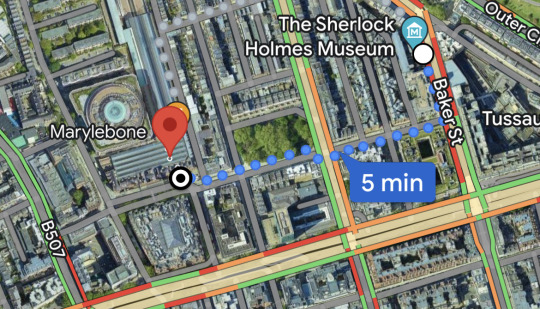
Aside: I think Sherlock is unlikely to catch a bus unless directly related to a case - they’re just too slow for him. But you can find bus maps and all kinds of other TfL mappy delights here.
If you have characters using public transport in the UK, your best bets for accurate research are:
Google Maps (in public transport mode)
National Rail (see the page footer for all the useful stuff)
Transport for London
All these also have apps available.
I’m happy to do Sherlockian Britpicking (my day job is copy-editing) if that’s helpful for you.
If you want to go the full Howard Shilcott, I still very much enjoy reading the rail enthusiasts’ forums posts about the myriad tube-related continuity errors in TEH. I’ll let you Google those for yourself. 😉
———
Ran this past my husband (who is totally the full Howard Shilcott) and he made a few corrections (and a lot of faces!) before I posted: he wishes it to be known that he ‘remains unhappy about [my summary of] Fenchurch Street’ and thinks I should add Charing Cross to the list so people know how to get to Kent. So that’s all clear then. 😂
#London#London travel#London transport#London Underground#London stations#trains#help for fanfic writers#fanfic#trains in England#railways#Railway Britpicking#Britpicking#Britpicker#Why yes I am autistic thank you#Howard Shilcott#info post#infodump#sherlock#British Rail#British trains#English trains#fanfic writing#fanfic Britpick#important details#Sherlock fanfic#Sherlock fanfiction#Sherlock locations
35 notes
·
View notes
Text
Cardiff, Wales: July 19-26, 2024
"I have no idea what I'm going to do in Cardiff" was a regular refrain as I fretted while planning my trip, and apart from pre-booking a Doctor Who tour, I decided to simply wing it when I got there, and that worked out really well.
I flew from Dublin to London Heathrow, then took the Tube to Paddington Station for the train to Cardiff, where I took this crappy through-the-train-window pic of the Paddington Bear bench, mainly so I could show my mom, since we read those books together when I was a kid and my grandma made me a Paddington Bear plushie.
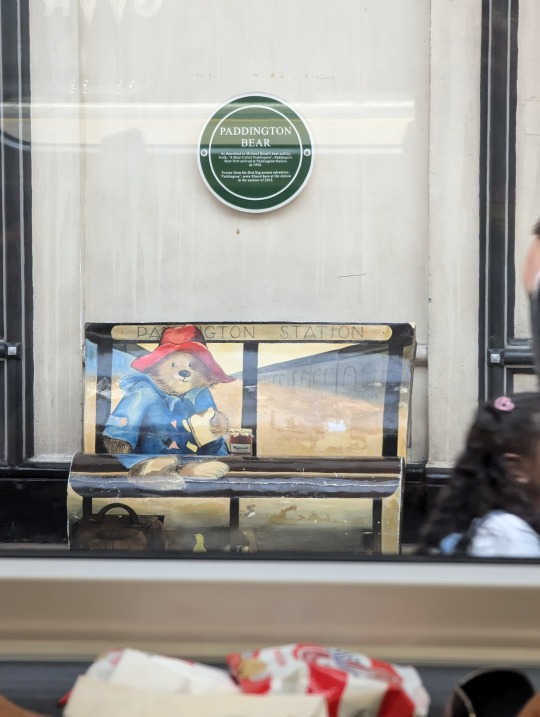
I got settled at my hotel in Cardiff and took it easy the rest of the day, and the next day I decided to do some easy walks for sightseeing and visited Cardiff Market, a fabulous, two-story indoor market full of shops and food stalls. I bought a couple of Welsh Cakes almost immediately and that was a very, very good decision.
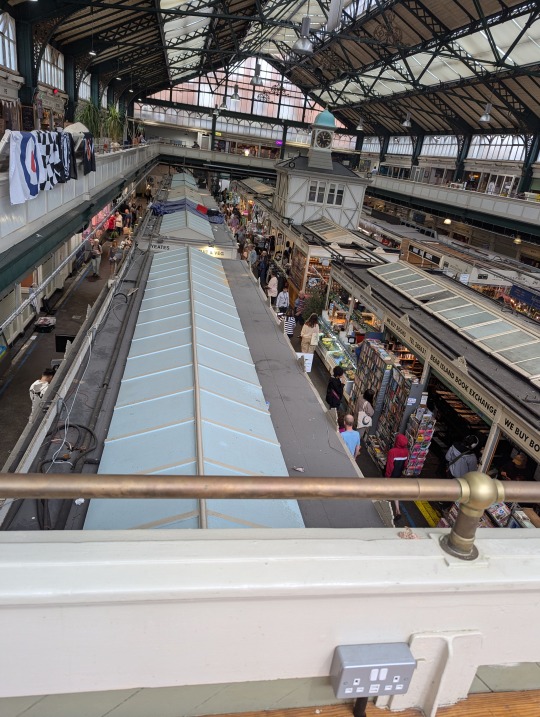
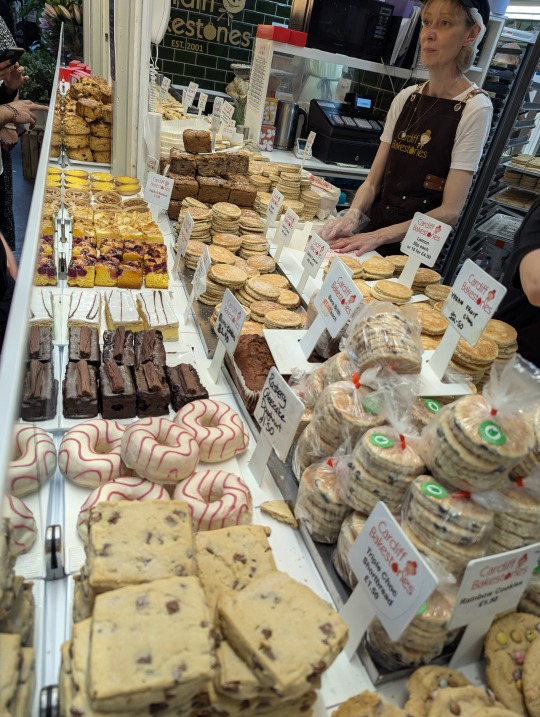
For the uninitiated, a Welsh Cake is basically a flattened scone cooked on a griddle and dusted with granulated sugar. At this shop, they sold them warm off the griddle, with the option to be served sandwiched with filling like lemon curd, Biscoff cookie spread, Nutella, or jam. I was instantly hooked and ended up getting Welsh Cakes for breakfast most of the mornings I was in Cardiff. It helped that they were less than a pound apiece, so it made for a very cheap breakfast (it only took two before I felt full).
Also, this shop in Cardiff Market is run by an American and I giggled at the name:
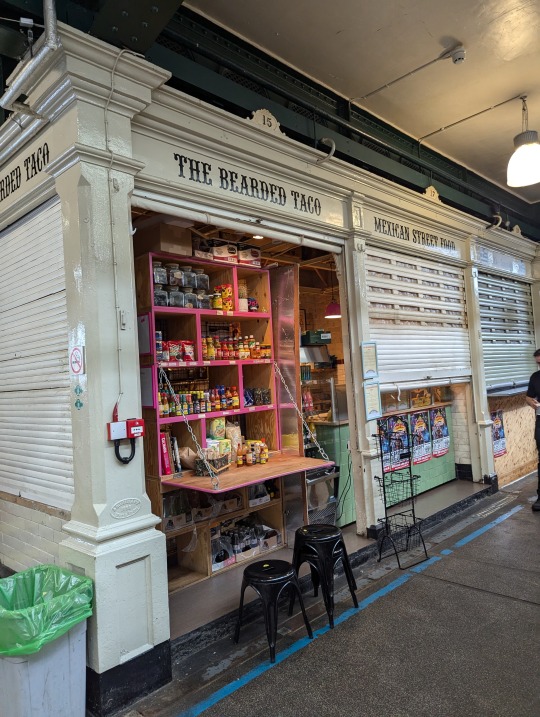
Another find on my first day was the Queer Emporium, a shop/coffee bar/cocktail bar where I felt right at home. I made it a point to stop there every day to buy a drink and fill up my "Gay Card." And one evening when I was wandering around, I stumbled upon a queer crafting night there and joined in to chat and do some cross-stitch with a small group of fellow neurodivergent queers, and that was a welcome bit of socialization during a trip that was sometimes a bit lonely.


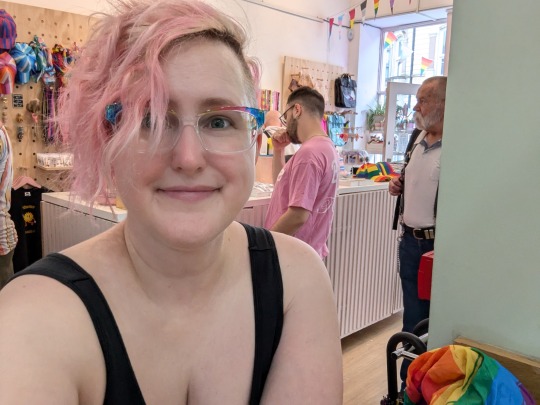
I really enjoyed shopping downtown and bought probably more stuff than I should have. There are tons of arcades (covered but open-air alleyways full of quirky and interesting shops and cafes), a beautiful library, and some cool-looking museums (most of which I failed to visit due to not feeling well my last day in town).
The day after my downtown exploration, I decided to visit Cardiff Bay, which includes Roald Dahl Plass, named for the author, a Ferris wheel (and yes, reader, I took a ride on it), a building that looks a lot like the Smithsonian Castle in DC, an historic Norwegian church-turned-cafe-and-craft-boutique, a phenomenal ice cream shop with some serious innuendo in its signage, and a very peaceful wetlands reserve with a wide bike and walking path and lots of birds.
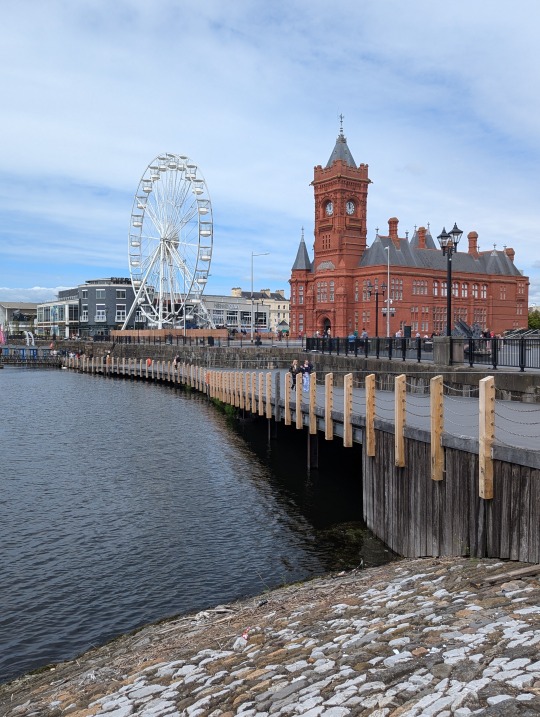
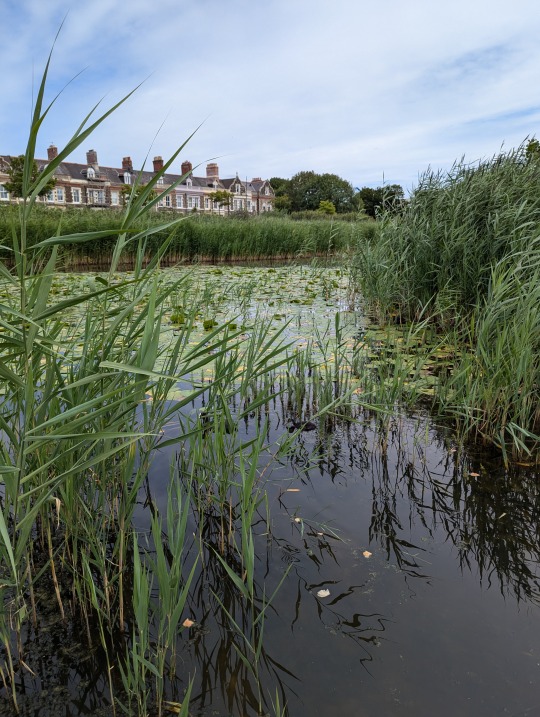


For my nerdy readers (probably most of you?), Cardiff Bay is also home to Torchwood Tower (so small - and surrounded by a family fun faire - I missed it my first visit and had to go back to see it again after my Doctor Who tour guide pointed it out) and Ianto's Shrine, which is still being curated ten years after "Torchwood" was canceled.


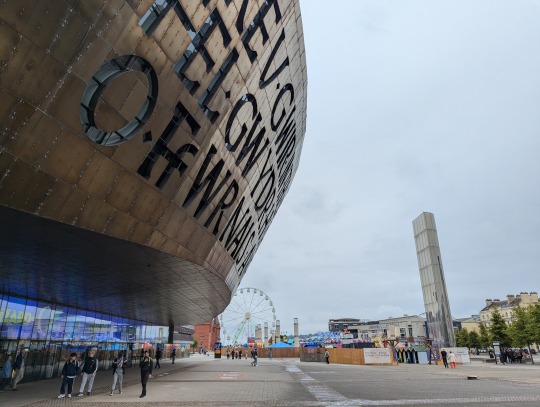
As I mentioned, I also did the Doctor Who tour, which was fun, and we had a really great and indulgent guide who showed us dozens of shooting locations from all the modern seasons of Doctor Who, right up through the Ncuti Gatwa episodes. Since most of the stuff we saw wasn't exactly scenic (mostly alleys and fronts of office buildings and shops), I didn't really take any photos, apart from one in St. John the Baptist Church, where keen observers will find a tiny Cyberman has replaced one of the knights up above the rear chapel altar.
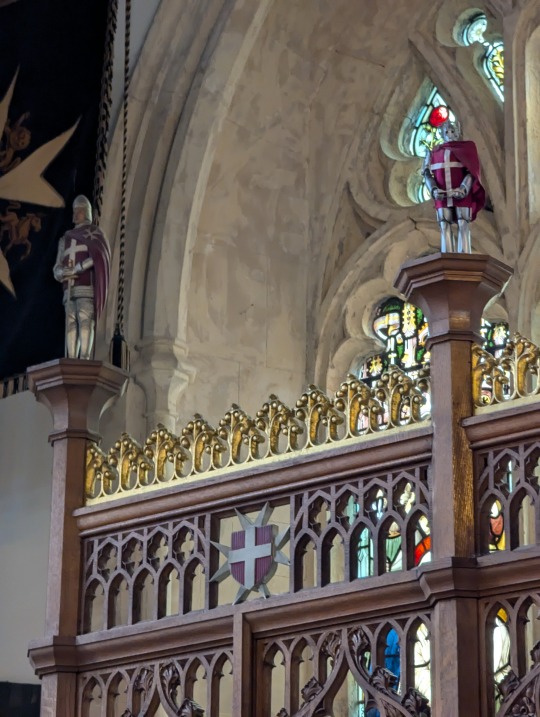
While in Cardiff I had another Adventure In Trying To Do Laundry, and in this episode, I took a bus to a not-great part of town where the laundromat was very good and the person running it was very kind and I met a nice couple from Seattle but most importantly, it had the most bonkers vending machine of hot-water-based potables I've ever seen.
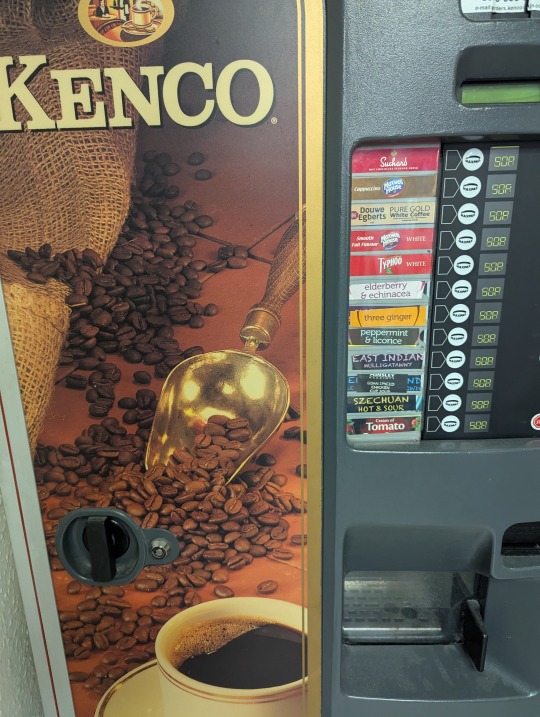
And while I was there, the vending machine was not operational because the electricity costs were too high at the time. (Many places in the UK have different electricity rates for different times of day and days of the week.) Not that I was tempted by the possibility of herbal tea that may have tasted like tomato soup.
The true highlight of Cardiff, however, was the Cardiff Castle tour, specifically the residence, but honestly the whole thing was an absolute delight, and it was my favorite castle to explore of all the castles I visited during my trip.
I didn't take a ton of photos, both to adhere to my five-photos-a-day rule and because I knew my photography equipment - er, phone - and skill were not up to the task of capturing some of the more magnificent sights (which is why I bought a book in the gift shop instead).
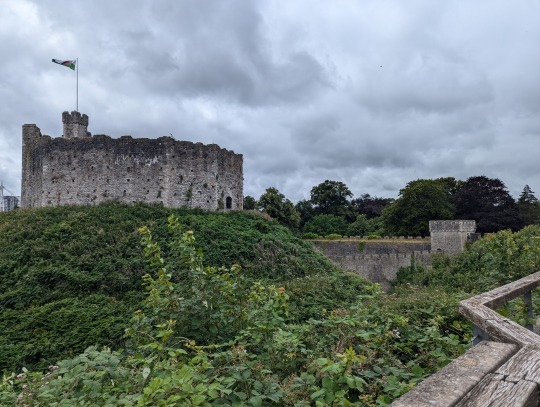
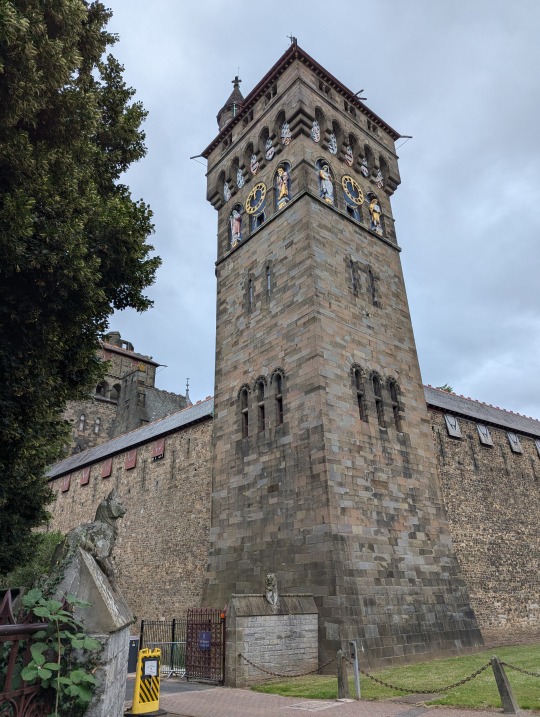
But. Let me tell you about this place. It is WILD. There's been a castle on that site for 2000 years, since the Roman occupation of Britain, so it has a really rich history and some absolutely bananas decor.
First off, when you buy your admission, there's a military history museum, which is actually pretty darned interesting even if you have no interest in military history. For one thing, there's a person demonstrating various swords and other edged weaponry from various historical periods. For another, there's this absolutely jaw-dropping, enormous sculpture? Relief? Mural? Thing? depicting the Roman rule era. It runs the entire length of a super-long hallway, and arcs around a corner as well. Absolutely astonishing. It was created in the 1980s, so it's not exactly historic in and of itself, but it's still an incredible sight to behold.
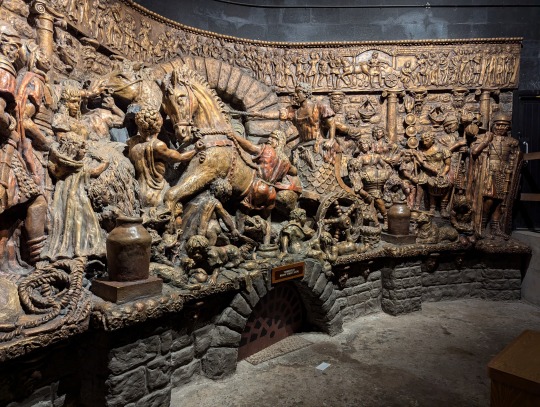

But the military history museum has nothing on the residence tour, which costs a few extra pounds but is well worth the expense. Our guide was a fabulous nonbinary person who I vibed with instantly and turned out to be a fan of my band, The Misbehavin' Maidens, which is rad enough to make the tour worth it, but holy shit this house. This HOUSE.
It was built in the Victorian era by the Scottish Marquis who owned it at the time, and he was incredibly wealthy thanks to the coal industry, so practically every surface in this mansion is covered in 22-karat gold. Here's the one photo I took that turned out decently, of the zodiac ceiling in the winter smoking room:
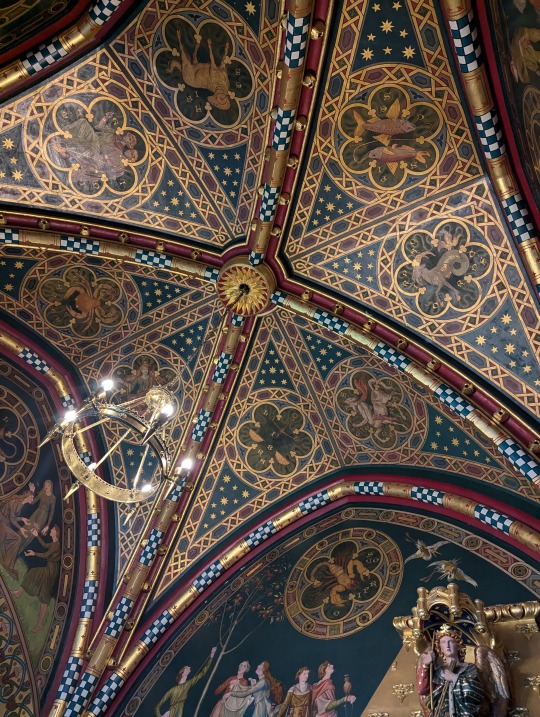
And that's not even the most opulent room in the place. Check out the Arab Room if you want to see something truly astonishing.
The funniest part of the tour was seeing the Marquis' bedroom and learning that he converted to Catholicism at age 21 to marry his wife, and kinda turned being Catholic into his whole personality, to the point where his bedroom has a wardrobe designed to look like a confession booth, and there are angel faces looking down at you from the ceiling, positioned so that no matter where you are in the room, at least one of them is staring at you at all times.
Every room had gorgeous art on the walls and ceiling, including a very detailed mural in the nursery featuring tons of storybook characters and storytellers.
As if that weren't enough to make for a fantastic day, then I got to run around in and among the ramparts, and as we know from my time spent in York, I love running around castle walls. It may be a new obsession of mine.

Another fun place in Cardiff Castle was inside the walls, where they created a bomb shelter in WWII and have up period-appropriate signs and play bits of radio from the time interspersed with the sounds of bombs dropping and air raid sirens. It's haunting and intense. I do question the choice of playing the song "We'll Meet Again," though. Someone on staff loves Doctor Strangelove!
I did break my five-photos-a-day rule the day before I left Cardiff to capture the Animal Wall of Cardiff Castle, though, and I have no regrets. Here are my faves, but you can see them all here.


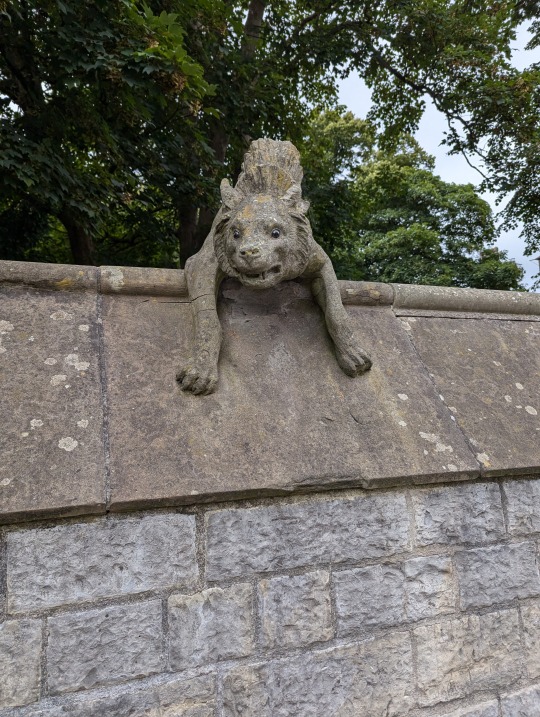
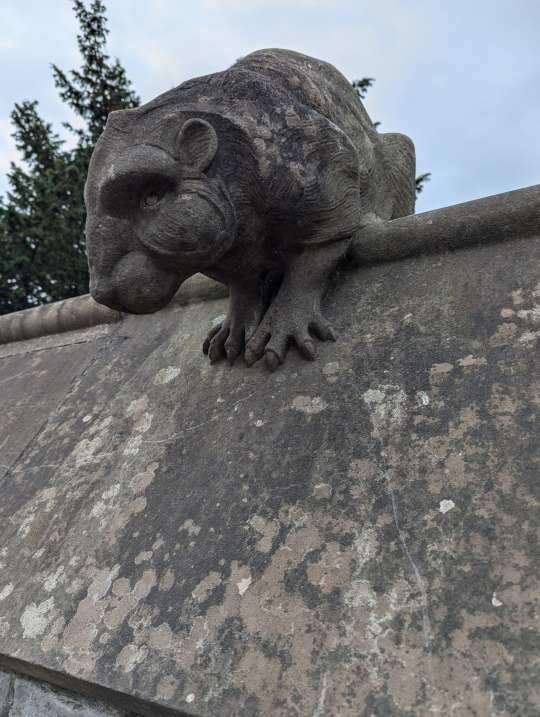
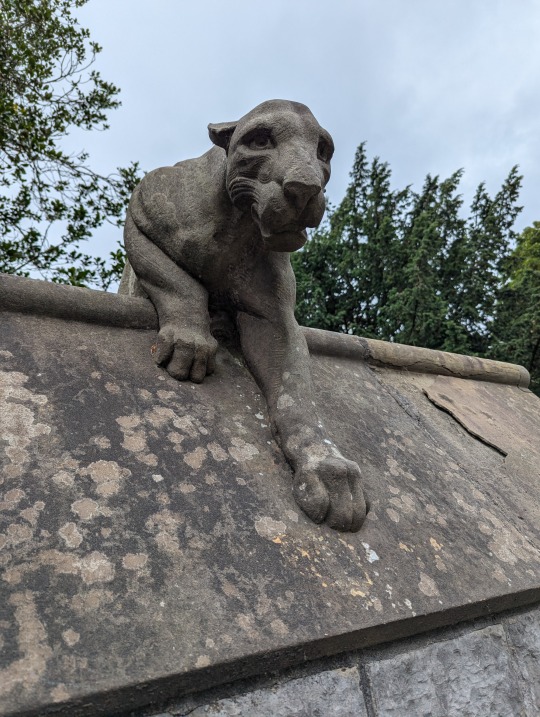
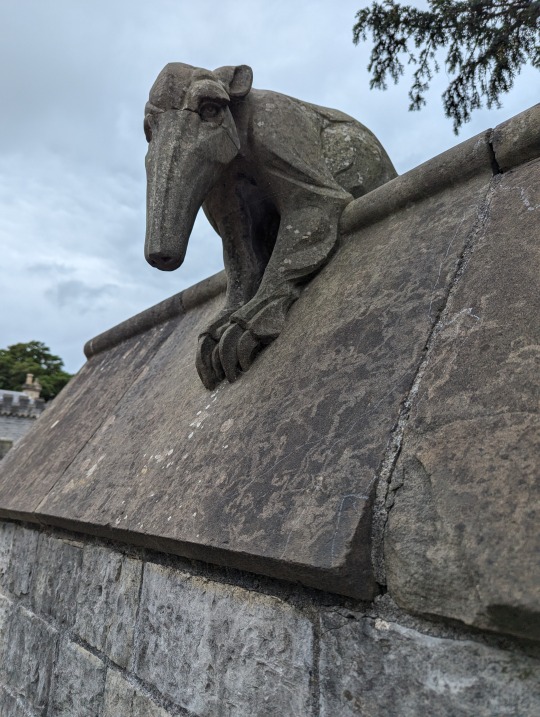
Overall, Cardiff was definitely a highlight of my trip and I had no trouble filling my time there with activities, even though I didn't have much of a plan before I went.
Though I kinda wish I'd stopped to have a drink at this place (fonts matter, people!):
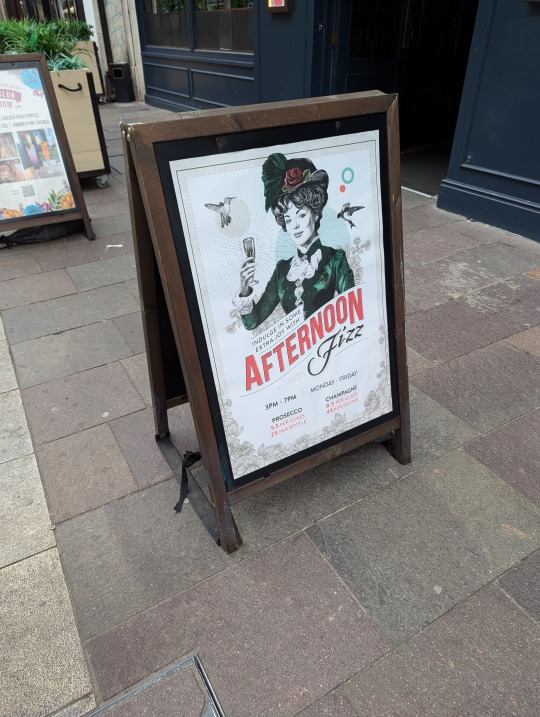
2 notes
·
View notes
Text

I was doing quite a bit of travelling this month, so audiobooks were a blessing (thank you for my life, P.G. Wodehouse). I had a few physical books that I carted around with me, but mostly I really appreciated the bliss of being able to pop in headphones and listen to a story on the plane or to help me fall asleep in assorted inn/hostel/hotels…

A Bear Called Paddington
Speaking of travel, of my destinations this month was the UK! Had an excellent trip, got all around the country, including London. I was thrilled to see the Paddington Bear statue at Paddington Station, so I decided I needed to reread the first book of the series since it’s been years since I read any of them.
A Bear Called Paddington tells the story of how a young bear “from Darkest Peru” winds up in London. The Brown family find him in at Paddington Station with a tag that says “please look after this bear, thank you”. Not able to stand leaving him on his own, they bring him home and that is, as they say, history. The stories are all quaint little adventures about the well-meaning Paddington exploring every day London life and the inevitable mishaps and misadventures he gets drawn into.

Black and White: Tough Love at the Office
Ah, the Toxic Yuri everyone’s been talking about! I honestly don’t quite know what to say about this one… this author had a very specific fetish she was going for and succeeded! It’s all about an office rivalry and how out of hand it gets, very kinky. There is absolutely nothing of substance here but tbfh if you read that title and decided to pick it up substance proooobably isn’t what you’re looking for. The art is nice! I wouldn’t bother reading more, but I had fun reading this.

Heidi
Another childhood classic I hadn’t read in years. It felt like a good summery read so I decided to revisit it since the last time I read it was probably late elementary school and I remembered having vaguely warm feelings for it. The story is about a young orphaned girl named Heidi and how she is sent to live with her gruff grandfather up in the Alps. Despite people having doubts about her doing well in such a harsh environment or with such a harsh man, Heidi takes to the mountains immediately and her bitter grandfather is soon softened by having her around. Things get complicated though when Heidi is taken away from her uncle and forced to live with another family, far away from her mountains and the world she knows…
I enjoyed it well enough. It was sweet and endearing like children’s books from this era are, though the moralistic Christianity was a little heavy fucking handed for this particular atheist. Could have done without. Not sure I’d bother rereading it again now that I’ve been reintroduced to the story, but it is a nice one and obviously a classic for a reason.


Into the River Lands // Mammoths at the Gates (Singing Hills)
I seriously can’t sing my love for The Singing Hills Cycle loudly enough. Go read it! Go go go! I was iffy when I read the first book, it took me a little bit to really understand what the book was trying to do, but by the time I hit the second book I was sold. By Into the Riverlands I was in love.
These stories continue to follow the cleric Chih as they travel the lands collecting story for their monastery which exists to keep detailed records of all sorts of stories, both historical and fictional. These books are fascinatingly meta, and tend to weave multiple stories together with the framing device of Chih in the present day and then whoever is telling them their stories. It means that things often aren’t said plainly and you have to pick apart these various stories and the biases they’re being told through in order to understand the overarching story of the novella. Into the Riverlands is about Chih trying to collect stories about legendary martial artists from the riverland region and the companions they joins up with to travel a dangerous river road. Mammoths at the Gates is about Chih returning to the monastery only to find that it’s been besieged by mammoths and that an important cleric has died. They get wrapped up in trying to help mediate both the siege, the death of the cleric, changing relationships, and how stories affect the way we feel about people.

Star Crossed
This one was… a comic. I’m not really sure what to say about it. My girlfriend bought it for the pretty art and lent it to me and it was… a fine read. The art was definitely pretty! But the pacing was brutal. There was some genuinely lovely ideas and the relationships that were set up seemed appealing, but everything happened at such a breakneck speed that there was really no chance to feel anything. I couldn’t tell you a damn thing about it anymore, honestly. A problem was no sooner introduced than it was resolved. This felt like it either needed to be a story with a much smaller scope, or it needed to extend over quite a few more books. Ultimately if you want a story about star people, and a king/body guard thing, and some nice art it wouldn’t hurt to read. But like… you aren’t getting much. Kinda just made me want to go and reread Dogsbody instead which did sentient star politics in a much more interesting way.

Right Ho, Jeeves // Very Good, Jeeves! // Thank You, Jeeves // Code of the Woosters // Joy in the Morning // The Mating Season (Jeeves & Wooster novels)
So! I got a little into the Jeeves books! They made absolutely perfect falling-asleep-books since, much like Bertie, they don’t take a lot of brain power. They’re like eating a bowl of popcorn for my brain. They were fun, silly, with just enough scheming to keep things interesting. I adore Bertie Wooster with my entire heart, and it’s always very fun to see Jeeves swoop in to save the day. My one condemnation is that this is very much a “if you’ve read one, you’ve read them all” sort of series. Which clearly worked for me! I wanted more of the same and by god I got it! Could not for the life of me tell you what each book was about, but I had a blast listening to them and intend to listen to more too after I’ve had a break. Every time Aunt Dahlia turns up my heart sings. I am also delighted to have reached the books that feature Gussie because he's also an absolute delight!
#book review#book reviews#forgive any spelling mistakes#this is very late (see: all the travelling) and i just wanted to knock this out before bed so i would stop putting it off#jeeves and wooster#p g wodehouse#queer books#queer lit#singing hills cycle#nghi vo#heidi#johanna spyri#paddington bear#a bear called paddington#black & white: tough love at the office#Toxic Yuri tm#for when you just want to watch two women kick the ever loving shit out of each other and maybe make out#enemies to enemies#considering the jeeves and wooster books are really really fun#they have some of the lousiest cover art i've seen#surely we can do better than THIS
2 notes
·
View notes
Text
My little trip is becoming more and more Good Omens Centric...
I swear, I think I'm going to call it my Ineffable Holiday. Firstly, of course, I've planned it around seeing David in MacBeth. Trying to break out of my 'Paddington rut', (and through the magic of British Airways and their payment plan holiday packages!) I have a hotel in Bloomsbury. 5 minutes from Tavistock 'Body Swap' Square, a hop to Soho, a skip to St James, and perhaps a jump (or two) to The Ritz.
OK, fine...
Next, I'm thinking at least one day trip outside of London. Someplace new, yet easy to to in a day, and not a lot of walking... OOh! I haven't been to Brighton since I was little - we're talking spade and pail and all the Grands are alive and well little. There's a 7 Sisters mini-van tour! Brilliant! It also explores the South Downs and the Devil's Dyke...
FINE.
I can't say I'm not excited - not by a long shot... but I wonder if I should ask for a small Tally's in the pub stop... Just because.

4 notes
·
View notes
Text
year to date little adventure journal, in case you care
jan 28: edinburgh, nadine shah. spent my sunday afternoon shopping for the important things (bed sheets and bath sheets) and the fun things (hair dye, book club novels). had a ramen lunch at the yo sushi on princes st watching sushi plates sail past the scott monument. dinner and drinks with friends then centre barrier at the assembly rooms. my 9th time seeing nadine, 3rd time since she started teasing the new album so 3rd time hearing topless mother, even light and greatest dancer live. she was sensational. always is.
jan 31: glasgow, depeche mode. as soon as i got back from seeing nadine i was on ticketmaster looking for a cheap seat. had to work on the train and in waverley station but worth it. arrived to find myself in the back row of the hydro but i loved it. nadine supporting was stunning, first time i've seen her from the back of a room and her voice filled the place. depeche was amazing too, a couple of hours of songs i adore including strangelove, behind the wheel, somebody, in your room, just can't get enough, policy of truth, black celebration, etc etc etc. i got up when they started walking in my shoes and danced through the entire show from that point on, safe in the knowledge that there was nobody behind me as i flailed around. it's given me the last-minute trip bug.
feb 9: glasgow, the 1975. a long trip with many connections to get to my airport hotel and then back out to the hydro. early entry door was so slow that i got in as the normal doors opened, damp from the rain, but i got a good spot down the front. didn't know the japanese house were making upbeat tunes now so their set was a surprise. still... at their very best was much like the show last year but loved it, especially the surprise of bagsy not in net. i swear matty made eye contact with me a few times; he's so good at that. staging was beautiful, as always. mad rush to get back to town for the airport bus.
feb 10: london, suedemas. a couple of months late this year because of tour in december. early flight to luton and a morning in maida vale, an afternoon in highgate wandering aimlessly in waterlow park and hanging out in the boogaloo. italian food and gossip and gifts at paddington, drinks then trekking across to hackney for an indie club that played 6 AM songs in the hour we were there. heartwarming to spend the day in the company of dear friends.
feb 22: leeds, nadine shah. filthy underneath on repeat on the train down. a little shopping time before dinner but the second hand record store prices appalled me. over at the brudenell there was no queue for the show so i hung in the lobby as nadine soundchecked her new songs. front and centre in the main room, 6 songs: the three she'd been playing at all her pre-album shows, plus keeping score, hyperrealism and french exit. stunning, again. she spotted me wearing her merch and gave me a big grin and wave. i love her.
feb 23: birmingham, the blackout. a huge french toast brunch at moose coffee, a train to brum, a wander round the bullring. ready for a weekend of big nostalgia seeing the band who defined my student years and first flush of independence; found myself singing along to the songs and doing all the little actions as if it had been weeks and not years since the last time. ended up on the barrier for the last couple of songs and snoz immediately pointed a drumstick at me with a grin. saw some old friends, waited a long time in the freezing cold to get a chat with each of the 6. lots of big hugs, catch ups, a "fucking love you!" greeting from Gavin. so special.
feb 24: london, the blackout. trains to kentish town, bumping into matthew on the way to the flat. an afternoon with my besties, tokyo diner bento, hot chocolates, the Cute exhibition. we hung out in the hello kitty disco and pretended to have a sleepover in the hannah diamond installation. seeing an old band with a new band friend - same set, different side of the stage. waited out in the cold to chat again, more big hugs and catch-ups including a long conversation with sean. so much easier to chat as adults when i pretend we're old friends and not a girl with the singer from the band she has a huge crush on. a perfect weekend.
mar 9: galashiels, swim school. a local gig, a band i barely know but have high hopes for. the kind of show where i can have a normal day and then hop on the bus in the evening; macarts, a place that feels like home now. swim school and her picture both great bands, the kind of gig where i didn't know a single song but wasn't wondering how many songs they had left.
coming up: sprints. a week of adventures with a brett anderson cameo or two. nadine again. olivia rodrigo. for one night only, the ninth wave. finally, eventually, being in front of suede again.
6 notes
·
View notes
Note
I’ve just came back from London. Going there fairly often … I’m no Londoner but if you need tips, Anon … hit me up. 😂 Best place to stay (in my opinion) is Paddington. It’s so central and super convenient. Always depends on your budget, where to stay and what to book. I’d recommend Greenwich (to visit not to stay) too, such a lovely place. If you like musicals and theatre, grab a ticket for one of the shows in the Westend. There’s a special app where you can get super cheap tickets. Follow secret.london on Instagram too, they have amazing tips. Lots of history & art … many museums are free, so go check that out. You need to go for Afternoon Tea in one of the fancy hotels because DELICIOUS. All the lovely markets too, great fachion, art, accessories and FOOD. Visit Hampstead. Harrod’s (plus Food Halls) is a must too. If you’ve hot a bit of time, venture outside of London as well. Visit Bath or Oxford, Brighton, Cambridge, Windsor (Castle). Amazing (free) view over London on the Horizon 22. Neasden Temple is cool. Visit Strawberry Hill House. St. Dunstan in the East (for some Dark Academy or Hogwarts after the war vibes). 😂 The Tulip Stairs are beautiful, the Fitzrovia Chapel as well. AND SO MUCH MORE. Have fun in my favourite city. 🫶🏻
OMG anon, thank you so much for sharing! I hope it will be helpful to the person who asked about this, and I'm totally getting the vibe just by reading :)
4 notes
·
View notes
Text
Big Europian trip 06/21/2023 - 09/11/2023
June 21-23, 2023
Surprise, surprise! Our BA Premium Economy tickets to London were upgraded to Business Class! This means we were able to enjoy the British Airways Lounge at SFO, had a nice G&T and some crisps, whilst relaxing on a comfy couch. Our Business Class seats were amazing- Elena is facing backwards, but we had loads of room. Meals were very good, and served on china and glassware. An auspicious start to our LONG holiday!
After arriving at Heathrow on Thursday afternoon, we had an easy time with border control and commuting to Paddington on the Elizabeth Underground line. On our walk to the Chilworth Hotel we saw the “man in the clock”, cleaning and repairing the inside of a clock on the side of a building. Two little boys (ages 4-6) and Elena were dazzled by the sight, convinced that it was real. Hours later, at dinner, Elena was devastated to learn from Edward that it was an animation. The magical crystal that is London was broken! In the evening we headed out for a walk to Little Venice, a charming canal area with long boats, restaurants and outdoor artwork. Had a light dinner and headed back for rest before embarking on our Cotswold hike.
2 notes
·
View notes